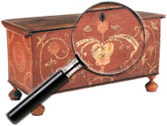|
|
Mills Restaurants, Ohio
J. O. Mills, a native of Marysville, Ohio, found very little good, home cooked food while on the road in his early career as a traveling salesman. To meet that need, and utilizing his background in hotel and restaurant accounting. Mills opened a small restaurant in I 915 in Columbus, Ohio, and put into practice his primary concept ‘good food at a moderate price’. The popularity of this restaurant led him [...] Click here to continue reading.
RumRill Pottery
While not as famous as the Roseville, McCoy, or Hill potteries, perhaps due to its shorter lifespan, RumRill Pottery still played an interesting role in the rich history of Ohio potteries that sprung up during the late 19th and early 20th centuries and has a story filled with twists and turns.
In 1930, George Rumrill, a Texan with a flair for sales, started a company in Arkansas to sell various art [...] Click here to continue reading.
The Sarcophagus in Decorative Arts
Derived from the Greek sarx, meaning flesh, and phagein, meaning eat, a sarcophagus is, essentially, a container for a body, much like a coffin or casket. Historically, sarcophagi were typically made of stone (though sometimes of other materials, such as wood or metal), with a relief-carved or pediment top, and designed to be above ground, and have been used by many cultures since ancient times.
An ancient [...] Click here to continue reading.
Hires Root Beer
While traveling in 1875, Charles E. Hires, a Philadelphia pharmacist, first tasted root beer. Root beer, traditionally made with sassafras, was a popular “small beer” or low-alcoholic drink in the colonial era, and was becoming popular in an alcohol-free format. While root beer has a long history, it has a wide range of recipes that call for everything from birch bark to vanilla, molasses to juniper berries, so Hires set out [...] Click here to continue reading.
Canning Jars
Canning jars, also called fruit jars, because early versions were primarily used for fruit, or Mason jars, after the best-known manufacturer, are one of those technological advances that have become so ubiquitous we’ve forgotten just how revolutionary the development of food preservation really was. Many of the greatest empires, events and discoveries of the 19th century were largely aided by the development of the canning process. Supplying armies, expeditions and explorations was [...] Click here to continue reading.
Viktor Schreckengost (1906-2008)
Creator of Groundbreaking Designs for Everything from Bikes to Bowls.
Artist and industrial design giant Viktor Schreckengot’s contributions to American product design was on par with the likes of Raymond Lowey and Walter Teague. Schrekengost was a major force on the American Industrial design scene since the early 1930s.
Schrekengost Attended Cleveland School of Art Born into a family of Ohio potters, Schrekengost entered the Cleveland School of art [...] Click here to continue reading.
Newcomb College Art Pottery
Before it was revered for its art, and more specifically for its art pottery, Newcomb College was the country’s first degree-granting college for women within a major university. Its founder, Josephine L. Newcomb, envisioned an environment in which women would learn both practical skills and academic knowledge when she proposed the creation of the college in the memory of her daughter H. Sophie Newcomb, who died at 15. New Orleans’s [...] Click here to continue reading.
Shimuel Timmerman, potter
Shimuel was a man of the times. He was a Justice of the Peace, fought in the Creek Indian War, and was a Confederate soldier. His only sibling, John, died as a POW at Camp Douglas, Illinois. His two sons continued to run the business after their father passed on. He is buried at the Wayfare Primitive Baptist Cemetery, Cow Creek, Echols County, Georgia. (Information provided to p4A by a granddaughter [...] Click here to continue reading.
Herend Porcelain
The Herend Porcelain Manufactory was started in 1826 in Hungary by Vince Stingl, he started by making earthenware pottery, but by 1839, went bankrupt and his creditor Mor Fischer took over the factory. Fischer started artistic porcelain manufacturing in this year. Herend subsequently became very successful, being popular with much of the European aristocracy and nobility. His sons took over the operation in 1874 and the company continues to produce fine hand-crafted [...] Click here to continue reading.
Brother Thomas Bezanson
Brother Thomas Bezanson was a Canadian-born artist who is best known for his finely thrown porcelain vessels and complex glazes. After studying philosophy at the University of Ottawa, he spent twenty-five years as a Benedictine monk at Weston Priory, Vermont, before becoming the artist-in-residence at Mount Saint Benedict in Erie, Pennsylvania. Bezanson believed in art as the language of the spirit, and he approached pottery as a monk would their daily [...] Click here to continue reading.
|
Recent Articles
- Charles Alfred Meurer – American Artist & Tromp L’Oeil Artist
- Sendak, Maurice – American Artist & Writer
- Godie, Lee – American Artist
- Davis, Vestie – American Artist
- Bartlett, Morton – American Artist
- Mackintosh, Dwight – American Artist
- Evans, Minnie Jones – African-American Artist
- Mumma, Ed (Mr. Eddy) – American Artist
- Nice, Don – American Artist
- Savitsky, John (Jack) – American Artist
- Gordon, Harold Theodore (Ted) – American Artist
- Dial, Thornton – African-American Artist
- Doyle Sam – American Artist
- Johnson, Lester Frederick – American Artist
- Finster, Howard – American Artist
|
|
